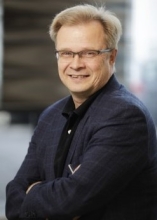
Academy Professor
Departments of Physics and Chemistry, NanoScience Center
University of Jyväskylä, Finland
Abstract: Monolayer-protected metal clusters (MPCs) are hybrid metal nanoparticles consisting of a metal core and a protecting layer of organic ligand molecules. They have a precise mass and chemical composition, and in many cases their structure is known to atomic precision. During the last decade, experimental and computational investigations of MPCs have burgeoned, yielding ample novel information about physical, chemical, catalytic, optical, biological and medical properties of these atomically defined nanomaterials. The often precise knowledge of the MPCs’ atomic structure creates an excellent starting point to use various atomistic simulation tools to understand their structure-property relations. However, MPCs can have complex interactions with their environments, which creates challenges to simulations due to needed length scales, time scales or the need to describe the complex chemical interactions properly on an equal footing. I will discuss challenges to model water-soluble gold MPCs that can be functionalized for biological imaging/sensing and drug-delivery applications, and propose possible pathways to consolidate current methods in future hybrid methodologies.
1. S. Malola and H. Häkkinen, “Prospects and challenges for simulations of monolayer-protected metal clusters“, invited Perspective, Nature Comm. 12, 2197 (2021).
2. M.F. Matus and H. Häkkinen, “Atomically Precise Gold Nanoclusters: Towards an Optimal Biocompatible System from a Theoretical-Experimental Strategy“, invited Concept Article, Small (2021). https://onlinelibrary.wiley.com/doi/10.1002/smll.202005499
3. E. Hulkko, T. Lahtinen, V. Marjomäki, E. Pohjolainen, V. Saarnio, K. Sokolowska, A. Ajitha, M. Kuisma, L. Lehtovaara, G. Groenhof, H. Häkkinen, M. Pettersson, ” Covalent and non-covalent coupling of a Au102 nanocluster with a fluorophore: energy transfer, quenching and intracellular pH sensing”, Nanoscale Advances 3, 6649 (2021).
4. K. Pyo, M. F. Matus, S. Malola, E. Hulkko, J. Alaranta, T. Lahtinen, H. Häkkinen and M. Pettersson, “Tailoring the interaction between a gold nanocluster and a fluorescent dye by cluster size: creating a toolbox of range-adjustable pH sensors”, Nanoscale Advances (2022) DOI: 10.1039/D2NA00487A
5. A. Pihlajamäki et al., ”Monte Carlo Simulations of Au 38 (SR) 24 Nanocluster Using Distance-Based Machine Learning Methods”, J. Phys. Chem A 124, 4827-4836 (2020).
6. M.F. Matus, S. Malola and H. Häkkinen, ”Ligand Ratio Plays a Critical Role in the Design of Optimal Multifunctional Gold Nanoclusters for Targeted Gastric Cancer Therapy”, ACS Nanoscience Au 1, 47- 60 (2021) (cover article).
Bio: Hannu Häkkinen is a professor in the Departments of Physics and Chemistry at the University of Jyväskylä in Finland, where he leads the Computational Nanoscience group at Nanoscience Center (NSC-comp). His group investigates physical and chemical properties of various nanosystems using computational techniques based on density functional theory, dynamical simulations and artificial intelligence. Häkkinen is a leader in the field of atomically precise, ligand-protected metal nanoclusters. His work has advanced understanding of the physical, chemical, catalytic and bio-compatible properties of nanoclusters and their self-assemblies, with potential applications in plasmonics, catalysis, biological imaging, sensing and drug delivery. Häkkinen has authored close to 300 scientific papers and has received a number of awards and recognitions for his research, including the Theodor Homen Physics Prize. He is a member of the Finnish Academy of Science and Letters. He was the Academy Professor for 2016-2020.
Host: Assistant Professor Stacy Copp
Share
Upcoming Events
-
MSE 298 Seminar: Mechano-Electrochemical Phenomena at Ceramic Electrolyte Interfaces
-
MAE 298 SEMINAR: Rapid Manufacturing and Assembly of High-Performance Thermoplastic Composites
-
CBE 298 Seminar: Beyond the Tailpipe - From the Science of Soot Formation to the Engineering of Carbon Nanomaterials
-
CEE Seminar: Pricing and Control in Emerging Mobility Systems
-
MSE 298 Seminar: Innovation In Materials Science - An Industrial R&D Perspective
